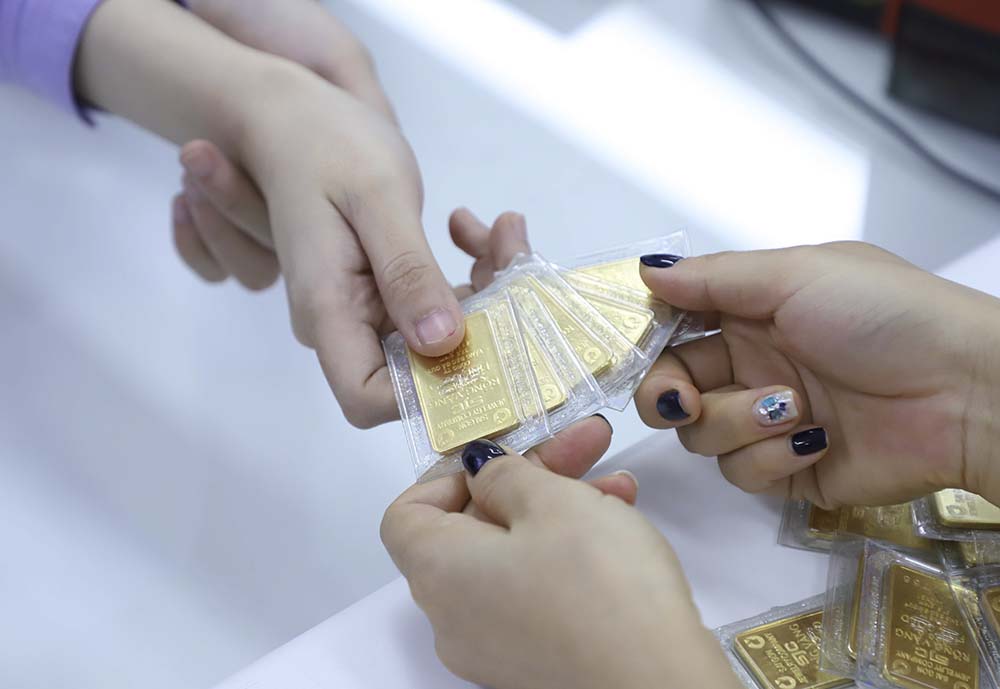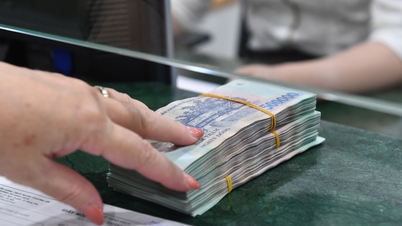It is not easy to determine the direction of the world gold market in 2025 with certainty, because there are simply too many unknowns. But the scenario of gold prices reaching or exceeding the 3,000 USD/ounce mark has been thought of.
It is not easy to determine the direction of the world gold market in 2025 with certainty, because there are simply too many unknowns. But the scenario of gold prices reaching or exceeding the 3,000 USD/ounce mark has been thought of.
 |
| It is predicted that the world gold price may exceed the threshold of 3,100 USD/ounce this year. |
Gold shows resilience in chaos
The outlook for gold will become less gloomy once Donald Trump’s economic and foreign policies take shape when he returns to the White House for a second term (Trump 2.0). A strong Chinese economy, continued easing by major central banks and a tense geopolitical environment could push gold prices higher. Conversely, if Trump’s policies spur inflation and weigh on the global economy, gold could come under pressure.
Looking back at the gold market during President Trump's four years in office (2017 - 2021), trade wars, political instability and even the specter of international conflict all drove investors to flock to gold - a time-tested hedge against instability.
The price of gold has soared in response to a series of geopolitical and economic shocks during President Trump’s first term. Few could have predicted that the price of gold would increase by more than 53% by the end of Trump’s first term in January 2021, to $1,841 an ounce (from $1,208 at the beginning of his term). Thus, the price of gold has increased at an average rate of 13% per year. This increase is part of a general trend that highlights the role of gold as a “safe haven” investment in times of uncertainty.
The gold market faces two-way risks in 2025 as the Fed's monetary policy, Trump's economic and foreign policies, and geopolitical developments become the main drivers.
With a second term under President Trump, analysts say the speculative fire in gold could be fanned, pushing prices to new record highs. According to a recent study by Goldman Sachs, escalating trade tensions and concerns about the sustainability of the US balance sheet could help fuel the gold price fire in 2025.
Gold hit an intraday record of $2,790 in late October 2024, when the World Gold Council warned in its quarterly demand trends report that the market had succumbed to FOMO (fear of missing out). Prices have since retreated throughout November 2024 and traded around $2,690 in the third week of January 2025, according to data from online trading platform Kitco.
Goldman Sachs noted that strong underlying demand for gold bars will continue to be seen by central banks looking to diversify their reserves after the Biden administration froze Russian assets as part of sanctions over the Russia-Ukraine conflict. Some central banks see gold as a more politically neutral asset that cannot be frozen by countries due to geopolitical risks.
According to Goldman Sachs, investment flows into exchange-traded funds (ETFs) will also push prices up due to cyclical capital flows from investors looking to hedge their portfolios against the expected impact of the Federal Reserve (Fed) cutting interest rates to 3.25 - 3.5% in the coming time.
Now, Goldman Sachs estimates that geopolitical risks could prompt speculators to return as the Trump transition team continues to shock markets with unconventional policies and cabinet appointments. This could push gold prices to $3,150 an ounce as speculators start betting on whether the U.S. economy will pressure its trading partners with new punitive tariffs as the country increasingly struggles to finance its massive budget deficits.
The US budget deficit of $1.83 trillion in fiscal year 2024 will need to be met by borrowing more, which could cause inflation if the Fed is forced to buy more US Treasury bonds with newly printed dollars.
Notably, the US continued to record a budget deficit of $86.7 billion in December 2024, according to the latest report of the Ministry of Finance. Although down 33% compared to the same period last year, the December deficit brought the total deficit in the first quarter of the US fiscal year 2025 to $710.9 billion, an increase of about $200 billion compared to the same period last year, or an increase of 39.4%. The US federal budget for fiscal year 2025 is implemented from October 1, 2024 to September 30, 2025.
“Inflation concerns and rising financial risks could spur speculation and higher ETF flows. Meanwhile, concerns about the sustainability of US government debt could prompt central banks, especially those with large reserves of US Treasury bonds, to buy more gold,” Goldman Sachs analysts said.
Furthermore, while specific factors may drive gold buying, such as central banks actively managing their gold reserve allocations or their increased demand in important jewelry markets such as India, a sharp and sustained rise in gold prices during times of uncertainty is often seen as a “vote of no confidence” in the USD as a store of value, as well as other fiat currencies.
2025 faces two-sided risks
The gold market faces two-way risks in 2025 as the Fed's monetary policy decisions, Trump's economic and foreign policies, and geopolitical developments become the main drivers.
In a bearish scenario, a easing of geopolitical tensions in the Middle East and/or a resolution of the Russia-Ukraine conflict could trigger a sharp correction in gold prices, given the extent to which the precious metal benefits from these conflicts throughout 2024.
Trump’s “America First” approach suggests that a Trump 2.0 administration will focus on domestic policies and may not prioritize international issues. In this regard, Trump may actively seek to initiate a resolution process in the first months of his second term.
A hawkish tone in the Fed’s policy outlook could weigh on gold prices this year. If efforts to reduce inflation don’t yield much, and the increased uncertainty surrounding the inflation outlook, especially if Trump continues to raise tariffs, could prompt Fed officials to hold off on gradually lowering interest rates. Unless there is a significant deterioration in the labor market, the Fed could adopt a more patient stance without worrying about triggering a recession.
Furthermore, the performance of the Chinese economy could impact the outlook for gold demand in 2025. If Mr Trump were to increase tariffs on Chinese imports, China could retaliate, potentially sparking another trade war between the two economic superpowers. A weaker economy in China – the world’s largest gold consumer – could therefore have a negative impact on gold prices.
On the upside, continued policy easing by major central banks globally could help gold prices rise further this year.
Without an inflationary shock, the Fed could continue to steadily reduce policy rates, sending US Treasury yields into a downward trend and boosting global gold prices. Even if the Fed becomes reluctant to cut rates, gold could still catch capital outflows from the euro and pound, and remain resilient against the dollar if the European Central Bank and the Bank of England ease policy aggressively.
An improving Chinese economy could also have a positive impact on gold prices. In early December 2024, a meeting of top Chinese officials revealed that Beijing plans to adopt “appropriately loose” monetary policy by 2025, along with a more proactive fiscal policy, to boost economic growth.
The good news for China is that annual inflation, measured by the change in the Consumer Price Index (CPI), has fallen to 0.2% by November 2024. As a result, China can stimulate its economy without worrying about inflation.
Central bank demand is one of the main catalysts for the gold market in 2024. “Central banks will remain a significant part of the market. Central bank gold purchases are policy-driven and therefore difficult to forecast, but our surveys and analysis suggest that current trends will continue,” the World Gold Council said in its 2025 gold market outlook.
“In our view, demand above 500 tonnes (the relative long-term trend) would still be positive for performance. We believe central bank demand will exceed that figure in 2025. But a slowdown below that level could put further pressure on gold,” the World Gold Council noted.
Source: https://baodautu.vn/kho-do-duong-cho-thi-truong-vang-the-gioi-nam-2025-d241075.html



![[Photo] Keep your warehouse safe in all situations](https://vphoto.vietnam.vn/thumb/1200x675/vietnam/resource/IMAGE/2025/10/1/3eb4eceafe68497989865e7faa4e4d0e)
![[Photo] President of the Cuban National Assembly visits President Ho Chi Minh's Mausoleum](https://vphoto.vietnam.vn/thumb/1200x675/vietnam/resource/IMAGE/2025/10/1/39f1142310fc4dae9e3de4fcc9ac2ed0)

![[Photo] Hanoi morning of October 1: Prolonged flooding, people wade to work](https://vphoto.vietnam.vn/thumb/1200x675/vietnam/resource/IMAGE/2025/10/1/189be28938e3493fa26b2938efa2059e)

























































































Comment (0)